#blue grenadier
Text
Daily fish fact #303
Blue grenadier!

Also called hoki! They live in depths of about 400 to 1000 meters (1312 to 3280 feet) and their diet consists largely of crustaceans, squid and lanternfish.
#fish#fishfact#fish facts#fishblr#marine life#marine biology#marine animals#sea life#deep sea#deep sea fish#deep sea creatures#deep sea life#sea animals#biology#zoology#hoki#blue grenadier
201 notes
·
View notes
Text
Today Sophia had a plate of 6 cheese biscuits then another 6 cheese biscuits and then she asked me for 6 choc chip cookies but the client came in and that was forgotten and she never got her cookies today
#oh and she ordered the fish and chips in the office and i think the really guy had to detour there when dropping her home#lmao#oh and she insulted his driving#she told him that he drives too slow#rude#anyway for dinner she's having blue grenadier fish (fried) with minimum chips and 2 dim sims and 2 potato cakes and#minimum maximum chips#i don't know#i could have the quantity of dim Sims and potato cakes wrong#she could have gotten an extra one of each for tomorrow#anyway
0 notes
Text
Who Wants a Non-Hessian German Troops of the American Revolution Uniform Identification Flow Chart?
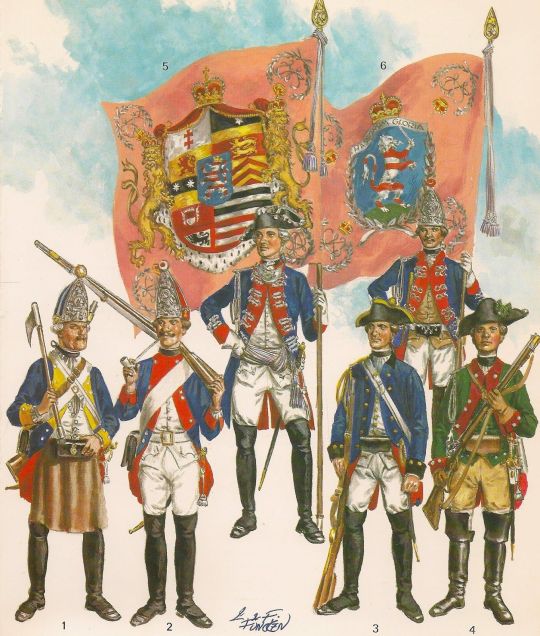
Now you too can roleplay as a harried British staff officer trying to identify which troops are encamped where, or a devious rebel spy collecting intelligence.
As folks may or may not know, only roughly 50% of the German state troops who served the British Crown during the American Revolution were “Hessians” from Hesse-Cassel. There were six other states that provided “subsidy troops.” Here’s how to tell them apart at a glance.
Are their uniforms predominantly dark blue? If yes, go to the paragraph numbered 4. If no, go to the para numbered 2.
2. Are their uniforms predominantly white? If no, go to the para numbered 3. If yes, those are troops from Anhalt-Zerbst. The only German state involved in the war to take its uniform and organisational cues from Austria rather than Prussia, the single Anhalt-Zerbst line regiment deployed to America wore white regimental coats faced with red. Their grenadiers wore bearskins rather than metal-faced caps (the only other German state to do this was Waldeck). One battalion also, according to one shocked British officer, had one of the most outrageous-looking uniforms of the war, including hussar hats, red and yellow waist sashes and red cloaks - these may have been “pandour” irregulars from the edges of the Austrian empire.

3. The coats are neither white nor blue, so they must be red. In this case, the troops are Hanoverian. While still mostly following Prussian style, because they shared a ruler with Britain, Hanoverian troops wore red. Five Hanoverian regiments assisted Britain with vital Mediterranean defence during the American Revolution, before going on to fight in India. They were the only redcoat Germans fighting for the Crown outside the British Army.
4. Your Germans are wearing blue coats. Are the buttons on the coat lapels arranged 1-2-1, and do the cuffs have a “Swedish” style slit to them? If no, go to the para numbered 5. If yes, they’re from Brunswick-Wolfenbüttel. Brunswick provided the most soldiers after Hesse-Cassel, and arguably the most rounded force, with four line regiments, one dragoon regiment, one grenadier battalion and one light infantry battalion. But whether jäger, musketeers or grenadiers, they almost all had coat buttons in groups of 1-2-1 and the slit-style cuffs. Fun fact; the Brunswick crest of a racing white horse on a red field was the same as neighbouring Hanover’s.

5. Your Germans are wearing blue, but don’t have buttons in 1-2-1 and Swedish cuffs. Do they have yellow facings, and cuffs with buttons placed both horizontally and vertically? If no, go to the para numbered 6. If yes, they are from Waldeck. This German state usually provided troops for the Dutch, but raised a new unit, the 3rd English-Waldeck Regiment, for service in America. They mostly fought against the Spanish in the Deep South, where they were decimated by disease. If the unusual position of the buttons on the cuff isn’t enough, look for the belt plate bearing “FF” for “Fuerst Friedrich,” the state’s ruler.
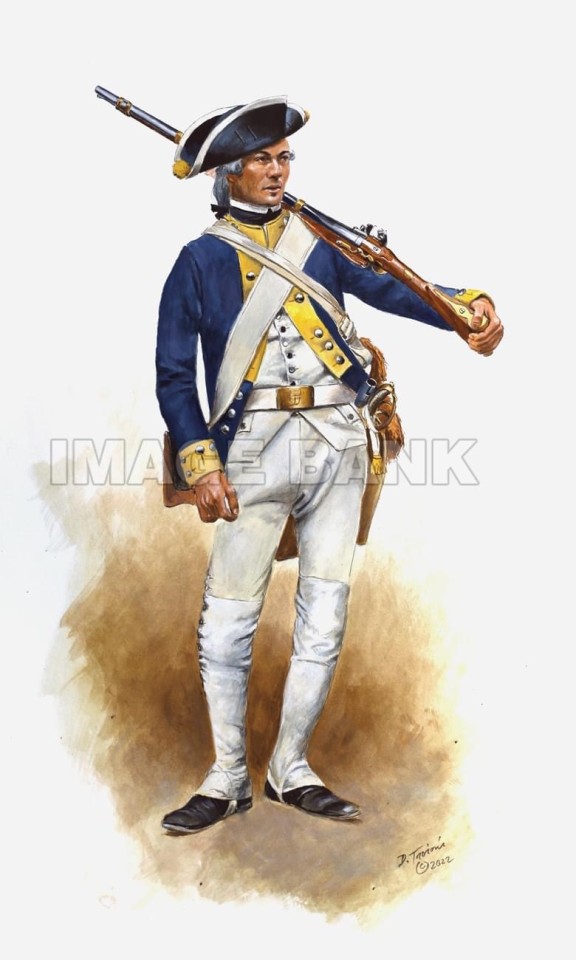
6. Do your blue Germans have red facings, cocked hats and unusual lace on their coats, shaped like a figure-of-eight? If no, go to the para numbered 7. If yes, they’re from Hesse-Hanau. This state was closely related (in the sense of its ruler, literally) to Hesse-Cassel, yet remained independent. While it provided a small amount of artillery, jägers and freikorps light infantry, its main contribution was a single line regiment, Erbprinz. Their distinctive features were scalloped lace on their cocked hats and the figure-of-eight “Brandenburg” style lace. There was also a Hesse-Cassel Regiment Erbprinz (even sharing the same colonel-in-chief), but they were fusiliers with caps rather than the Hesse-Hanau musketeers with their cocked hats. Check the mistake made by this artwork - these are Hesse-Hanau soldiers from the Infanterie Regiment Erbprinz, but they’re wearing Cassel fusilier caps. Bonus fact; Hanau and Cassel’s crest both features a rampant lion with red and white stripes, but there are subtle differences - they face opposite directions, the style of stripes are slightly different, and the Hanau lion lacks the Cassel one’s crown, but does wield a sword.

7. Do your blue-coated Germans have a black eagle on their flags and grenadier cap plates? If no, they’re probably from Hesse-Cassel. If yes, they’re from Ansbach-Bayreuth. This German state consisted of two provinces, Ansbach and Bayreuth (funny that). Besides jägers and some battalion guns, their main contribution was two infantry regiments, one from each of the two provinces. Their ruler’s crest was a black eagle, similar to the Prussian one.

Of course these posts don’t account for the uniforms of the jäger corps, or musicians, or any artillery, but it can serve as a rough guide. For the proper detail, you’ll have to buy my forthcoming book on the topic!
Also would be pretty cool if someone made an actual flow chart out of this, just saying!
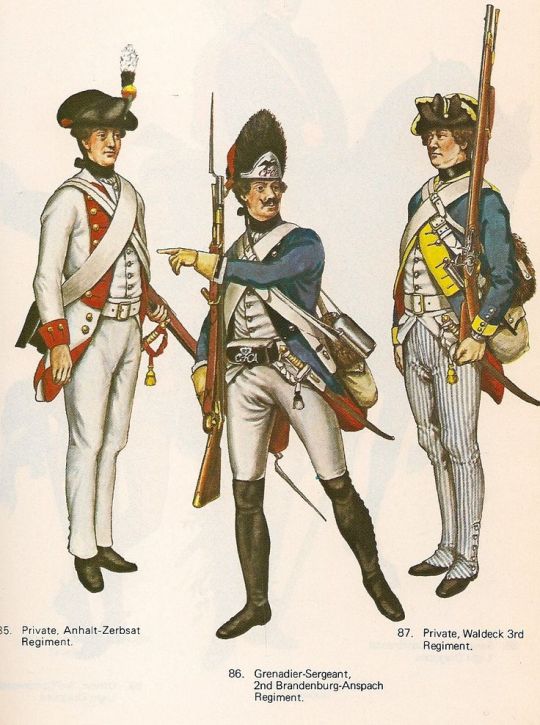
#hessian#hessians#german#germany#german army#german military#18th century#history#military history#american revolution#revwar#american war of independence
344 notes
·
View notes
Photo
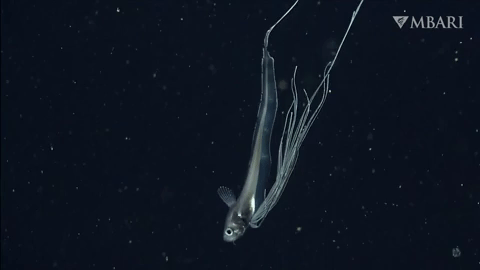
Tiny rattail cuteness stealing our hearts 😍🥰
Baby rattail fishes, family Macrouridae (500 meters/1,650 meters deep), live up off the bottom, in the open waters of the midnight zone, to avoid being eaten by seafloor predators. Adults are slow-growing and long-lived, reaching up to 70 years old or even older. In some areas of the world, the grenadier fishery is removing adult rattails faster than the remaining population can reproduce.

Rattails use those big blue eyes to glimpse even the faintest flickers of bioluminescence—the “living light” produced by deep-sea animals. Their keen eyesight reveals prey, like fishes and squid, darting in the waters above the seafloor. A rattail relies on other senses, like smell and touch, to find a meal too. It has a nose for rotting carrion, and sensitive barbels on its chin detect small crustaceans or worms wiggling in the mud below.
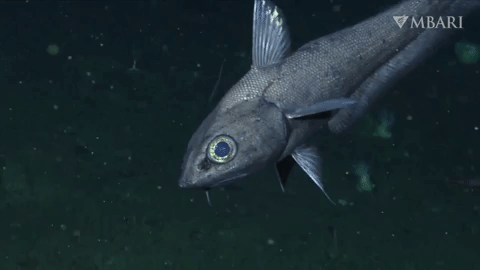
Humans play a pivotal role in deep-sea food webs too. As fish stocks in the ocean’s sunlit shallows dwindle, fisheries cast their nets to deeper waters. You might see “grenadier” as the catch of the day in restaurants and seafood markets—that’s a deep-sea rattail fish sold under a more palatable market name. Rattails and other deep-sea fishes grow slowly and mature late in life, making them vulnerable to overfishing. Additionally, the gear used to catch these fishes may harm seafloor habitats or unintentionally catch other species too. Thankfully, effective management for rattail fisheries on the West Coast has reduced the risk of overfishing and habitat damage. The Monterey Bay Aquarium’s Seafood Watch guide can help you make seafood selections that keep ocean health in mind.
547 notes
·
View notes
Text
Musicians' Uniforms in the Revolutionary War

(Artwork by the legendary Don Troiani)
A favorite descriptor of mine states that British drummers and fifers of the Georgian era were "birds of very gay plumage throughout the whole of the 18th century," a phrase which has irrevocably rooted itself in my head whenever I think of these colorful lads. Often there is curiosity about the vibrant getup of these gents, simply because they blatantly don't fit in with the rest of their units—which happens to be precisely the point.
The reason behind these colorful coats is that musicians had to be the most stand-out members of their regiment: they functioned as the voice of the officers on the battlefield and therefore had to be easily locatable at any given time. Officers would communicate via their musicians in order to convey significant large-scale orders, such as to retreat or cease fire—orders you can imagine quick communication would be vital for—and in the fog of war it would have been difficult to pick a handful of musicians out of a sea of similarly-uniformed men-at-arms. Thus, the musicians wore the inverse colors of their regiments, with the regimental facing colors becoming the main color of the coat, and (in the case of the British army) the standard red coat color becoming the color of the facings. The fellow pictured above is a drummer from the 63rd Regiment of Foot, which was faced with "very dark green" according to the 1768 clothing warrant, and thus the green is the body color of his coat.
These uniforms were also elaborately ornamented with the regimental lace pattern, as you can see above, whereas on the coats of men-at-arms this lace was restricted to the buttonholes on the facings. The smallclothes would still generally be white or buff, matching whichever color smallclothes the men-at-arms wore, unless the regiment was faced in white or buff, in which case the smallclothes would be red so they wouldn’t be the same color as the coat. The regulations were quite specific, as you can tell, but it serves to emphasize the degree of importance the musician held in the 18th century army.
There is some debate as to whether musicians wore cocked hats or bearskins, like the drummer pictured above. Musicians were technically considered part of the grenadier company of a regiment, which is why they bear red "wings" on the shoulders of their uniform and why they often wore bearskins, but there exists evidence of them wearing cocked hats, as well, so it seems likely that depending on the regiment they could have worn either. They would be armed only with a short sword worn across the waist, as they generally were not expected to participate in actual combat. The instruments themselves also functioned as part of the uniform, in ways: the regimental drum was always painted in the facing color of the regiment, and in the case of fifers, the fife sling would also be colored according to the regimental colors—see the 22nd Regiment's "candy colored cord,” as we call it, below (as well as the red smallclothes, as they are a buff-faced regiment... featuring myself and my janky uniform on the right!).

(Photo by Jeff Bross)
As far as I know the Continental Army generally abided by these same practices, which is why you occasionally get instances of the "American redcoat": certain musicians from the Continental army wore red coats with blue facings, looking much like their British adversaries, because they came from Continental regiments faced with red. This kind of cross-army confusion did not occur with the British, however, as those regiments faced in blue were the Royal regiments, and, in accordance with this honor, the musicians of these regiments kept the standard red coat with blue facings as opposed to inverting them (they were, however, still distinguishable by their copious amounts of lacing). Just goes to show that not every red coat is a Redcoat, and not every Redcoat wears a red coat!
#you know I had to do a post on this eventually#it's only my favorite subject ever or whatever#amrev#revwar#american revolution#revolutionary war#awi#field music#military history#18th century military#18th century#18thc#redcoat#uniforms#fife and drum#redcoatposting#the captain's lectures#this is your captain speaking
45 notes
·
View notes
Text
@pyramultimuse
"Hurry! Get the package into the truck!"
"They need reinforcements up above. Squad B come with me. The rest of you get the asset out of here!"
The metal plating around the bulletproof glass tank was slowly pulling away to reveal it filled to the brim with mako. The greenish blue hue faintly illuminates the area around it as the infantry and scientists around work hurriedly. A large data pad on the front is accessed by one of the scientists, rapidly typing in a code as something within the tank shifts. As the tank is slowly pushed towards the armored vehicle that would be transporting it to one of Shinra's more secret laboratories. The attack through the building sent infantrymen scattered around and shooting at anyone that was remotely a suspect.
"Careful! Hojo will have our heads if this fails."
The bright lights above finally dim, allowing sight into what was submerged inside, forced into a state of dormancy from the lines hooked into it and needles. The sword resting upon his back as blonde locks float in the liquid, he has no oxygen mask placed on, suggesting the subject may already be deceased or lacked the need for oxygen. A slight twitch in gloved hands suggests the latter.

The tank is lifted by a crane, holding tight to the top of it before beginning to slowly lift it towards the open truck. One scientist gazing towards the hallway as steps ring out. Tension and paranoia rising in the air as riot shields make their way towards the front, a few grenadiers taking point above while riflemen line up behind the shields, ready to lay down suppressing fire.
The clone within twitches. A single white wing pressed close against his body with straps. No doubt to make sure it didn't bang against the glass during transport, the edges are flakes of aquamarine speckles mixed with edges of green. Much like the substance he was submerged within.
The crane whines with effort, attempting to rush to place the asset within the truck for a speedy getaway.
26 notes
·
View notes
Text
The Anointing Screen
The Anointing Screen has been designed and produced for use at the most sacred moment of the Coronation, the Anointing of His Majesty The King. The screen combines traditional and contemporary sustainable embroidery practices to produce a design which speaks to His Majesty The King’s deep affection for the Commonwealth. The screen has been gifted for the occasion by the City of London Corporation and City Livery Companies.

The Anointing takes place before the investiture and crowning of His Majesty. The Dean of Westminster pours holy oil from the Ampulla into the Coronation Spoon, and the Archbishop of Canterbury anoints the Sovereign on the hands, chest and head. It has historically been regarded as a moment between the Sovereign and God, with a screen or canopy in place given the sanctity of the Anointing.
The Anointing Screen was designed by iconographer Aidan Hart and brought to life through both hand and digital embroidery, managed by the Royal School of Needlework. The central design takes the form of a tree which includes 56 representing the 56 member countries of the Commonwealth. The King’s cypher is positioned at the base of the tree, representing the Sovereign as servant of their people. The design has been selected personally by The King and is inspired by the stained-glass Sanctuary Window in the Chapel Royal at St James’s Palace, which was gifted by the Livery Companies to mark the Golden Jubilee of Queen Elizabeth II in 2002.
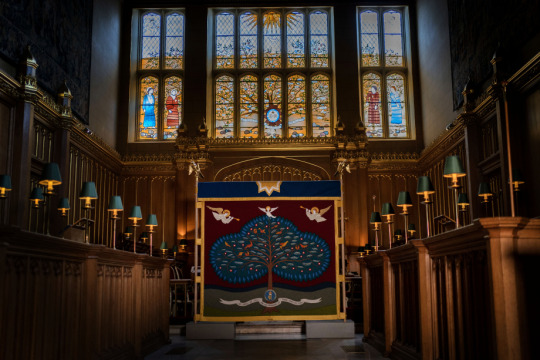
The Anointing Screen is supported by a wooden pole framework, designed and created by Nick Gutfreund of the Worshipful Company of Carpenters. The oak wooden poles are made from a windblown tree from the Windsor Estate, which was originally planted by The Duke of Northumberland in 1765. The wooden poles have been limed and waxed, combining traditional craft skills with a contemporary finish.
At the top of the wooden poles are mounted two eagles, cast in bronze and gilded in gold leaf, giving the screens a total height of 2.6 metres and width of 2.2 metres. The form of an eagle has longstanding associations with Coronations. Eagles have appeared on previous Coronation Canopies, including the canopy used by Queen Elizabeth II in 1953. Equally, the Ampulla, which carries the Chrism oil used for anointing, is cast in the shape of an eagle.

The screen is three-sided, with the open side to face the High Altar in Westminster Abbey. The two sides of the screen feature a much simpler design with maroon fabric and a gold, blue and red cross inspired by the colours and patterning of the Cosmati Pavement at Westminster Abbey where the Anointing will take place. The crosses were also embroidered by the Royal School of Needlework’s studio team.
At the Coronation Service, the Anointing Screen will be held by service personnel from Regiments of the Household Division holding the Freedom of the City of London. The three sides of the screen will be borne by a Trooper and Guardsman from each of The Life Guards, Grenadier Guards, Coldstream Guards, Scots Guards, Irish Guards, and Welsh Guards.
The screen has been gifted for the Coronation by the City of London Corporation and participating Livery Companies, the City’s ancient and modern trade guilds. His Majesty The King is a keen advocate and supporter of the preservation of heritage craft skills, and the Anointing Screen project has been a collaboration of these specialists in traditional crafts, from those early in their careers to artisans with many years of experience.
The individual leaves have been embroidered by staff and students from the Royal School of Needlework, as well as members of the Worshipful Company of Broderers, Drapers and Weavers.
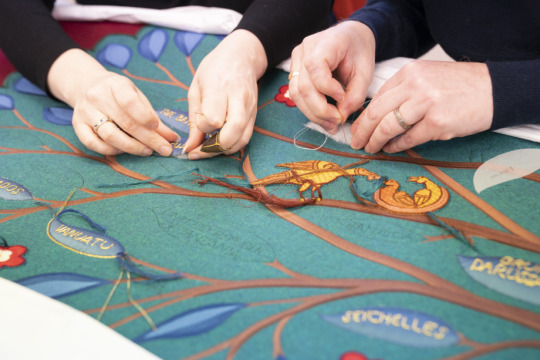
As well as heritage craft, contemporary skills and techniques have formed part of this unique collaboration. The outline of the tree has been created using digital machine embroidery by Digitek Embroidery. This machine embroidery was completed with sustainable thread, Madeira Sensa, made from 100% lyocell fibres.
The threads used by the Royal School of Needlework are from their famous ‘Wall of Wool’ and existing supplies that have been collated over the years through past projects and donations. The materials used to create the Anointing Screen have also been sourced sustainably from across the UK and other Commonwealth nations. The cloth is made of wool from Australia and New Zealand, woven and finished in UK mills.
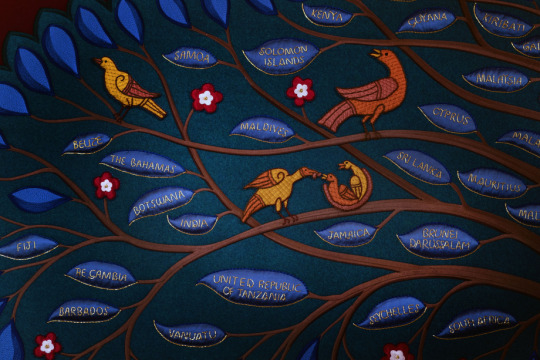
The script used for the names of each Commonwealth country has been designed as modern and classical, inspired by both the Roman Trojan column letters and the work of Welsh calligrapher David Jones.
Also forming part of the Commonwealth tree are The King’s Cypher, decorative roses, angels and a scroll, which features the quote from Julian of Norwich (c. 1343-1416): ‘All shall be well and all manner of thing shall be well’.
This design has again been inspired by the Sanctuary Window in the Chapel Royal, St James’s Palace, created for Queen Elizabeth II’s Golden Jubilee in 2002. At the top of the screen is the sun, representing God, and birds including the dove of peace, which have all been hand embroidered by the Royal School of Needlework.
The dedication and blessing of the Anointing Screen took place earlier this week at the Chapel Royal, St James’s Palace, where it was officially received and blessed by the Sub-Dean and Domestic Chaplain to The King, Paul Wright, on behalf of The Royal Household.
117 notes
·
View notes
Text

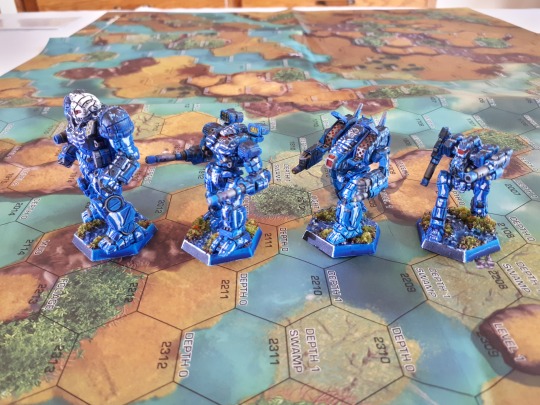
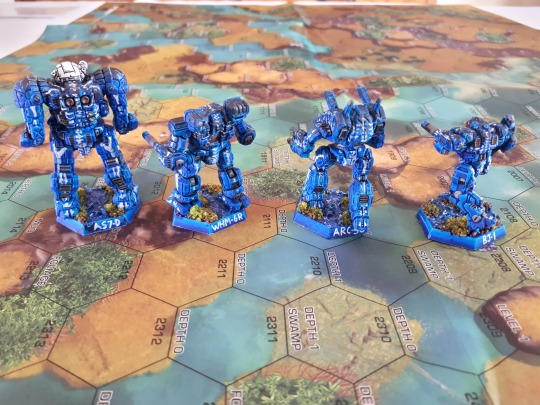


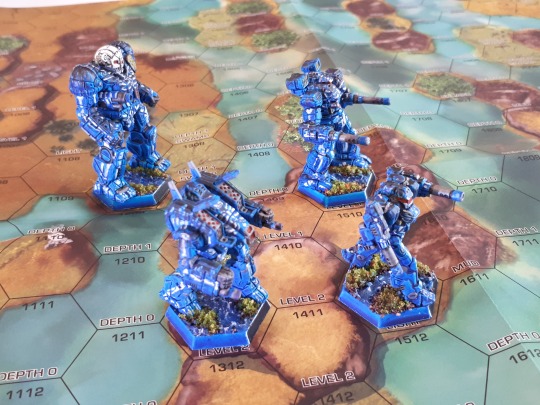



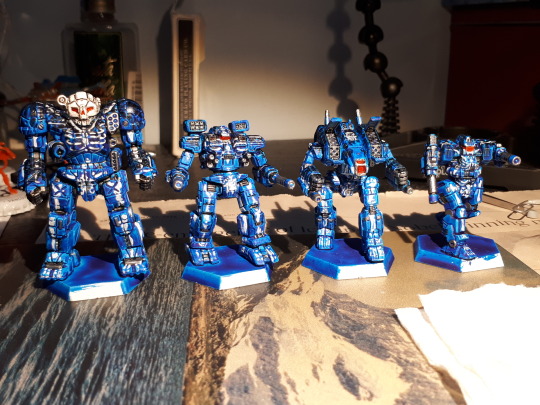


IS Heavy Lance from the Alpha Strike box set, IS Scout Lance and Clan Star to follow. Map beneath them is Racice River Delta.
"Kestrel's Lament"
(Combined schemes of Kestrel Grenadiers + Stone's Lament)
A few WIP shots at the end of the reel.
This was pretty fast, white primer + blue speedpaint quickly slathered on got most of the job done. Basically looks already washed, and even has a partly drybrushed look. From there I put metallic black near the tops to make the blue into a flame pattern, then white bones. A little dusting of white drybrushing to bring back the shapes concealed by the black metallic paint and presto.
Steel on weapons/heatsinks/joints and other functional parts of the mech, a touch of heat-treatment blueing on laser/PPC barrels, colored highlights on cockpit glass/searchlights/lasers, black wash on the Atlas skull. River bank basing made with water medium + stone + grass flock.
Also first time putting red/orange/yellow into the rear heatsink gratings to make an "overheating" look.
24 notes
·
View notes
Text
PRESS RELEASE
FURTHER MILITARY APPOINTMENTS FOR MEMBERS OF THE ROYAL FAMILY
Following His Majesty's Accession, The King is pleased to announce further military appointments for working Members of the Royal Family.
The new appointments will continue to reflect the close relationship between the Armed Forces and the Royal Family in His Majesty's reign.
His Majesty The King
The King will take on the following military affiliations:
Sponsor, HMS Queen Elizabeth
Colonel-in-Chief, The Royal Scots Dragoon Guards Colonel-in-Chief, The Royal Tank Regiment
Captain General, The Royal Artillery Captain General, The Honourable Artillery Company Colonel-in-Chief, The Royal Regiment of Scotland Royal Honorary Air Commodore, RAF Marham Air Commodore-in-Chief, RAF Regiment
The King, as Sovereign, is Head of the Armed Forces. His Majesty is a military veteran himself, having trained and served in both the Royal Navy and the Royal Air Force.
Her Majesty The Queen
Patron, The Royal Army Chaplains' Department
Her Majesty The Queen has a range of military affiliations, and was recently announced as the new Colonel-in-Chief of The Royal Lancers. The Queen's father, the late Major Bruce Shand, served with the 12th Lancers during World War II. Her Majesty's other military appointments include Colonel Grenadier Guards and Colonel-in-Chief of The Rifles.
His Royal Highness The Prince of Wales
Colonel-in-Chief, The Mercian Regiment Colonel-in-Chief, The Army Air Corps
Royal Honorary Air Commodore, RAF Valley
The Prince of Wales has a strong affiliation with the Armed Forces, having served in the Army as a Platoon Commander in The Blues and Royals, before completing flying training in the Royal Air Force. His Royal Highness served as an RAF Search and Rescue pilot, spending three years at RAF Valley in Anglesey, Wales.
Her Royal Highness The Princess of Wales
Commodore-in-Chief, Fleet Air Arm Colonel-in-Chief, 1st Queen's Dragoon Guards
Royal Honorary Air Commodore, RAF Coningsby
The Princess of Wales's existing military appointments include Colonel, Irish Guards and Royal Honorary Air Commodore of the Air Cadets. Her Royal Highness is also Sponsor of HMS Glasgow - the first of the Royal Navy's new Type 26 Frigates which is currently under construction. The Princess's grandfather served in the Royal Air Force.
His Royal Highness The Duke of Edinburgh
Colonel-in-Chief, The Royal Dragoon Guards Colonel-in-Chief, The Queen's Royal Hussars
The Duke of Edinburgh holds a range of military appointments. For twenty years, His Royal Highness has served as Royal Honorary Colonel of The Royal Wessex Yeomanry, whose troops have deployed in support of both The Queen's Royal Hussars and The Royal Dragoon Guards. His Royal Highness is also Royal Colonel of 2nd Battalion The Rifles, and was recently announced as Colonel-in-Chief of The London Guards.
Her Royal Highness The Duchess of Edinburgh
Colonel-in-Chief, The Royal Irish Regiment Roval Colonel, The Queen's Own Yeomanry
The Duchess of Edinburgh's military appointments include Royal Colonel of 5 Battalion The Rifles and Honorary Air Commodore of RAF Wittering. Every year, The Duchess holds an annual competition in which Her Royal Highness's affiliated regiments from the UK and Canada compete against each other in a series of challenges, to foster cooperation.
Her Royal Highness The Princess Royal
Deputy Colonel-in-Chief, The Royal Regiment of Scotland
The King has been pleased to appoint The Princess Royal Deputy Colonel-in-Chief, The Royal Regiment of Scotland, recognising Her Royal Highness's strong links to Scotland and existing links with the Regiment as Colonel-in-Chief of both 15* Battalion The Ranger Regiment (formerly 1st Battalion The Royal Regiment of Scotland) and 6th Battalion, The Royal Regiment of Scotland.
His Royal Highness The Duke of Gloucester
Air Commodore-in-Chief, Royal Auxiliary Air Force
The Duke of Gloucester has been Patron of the Royal Auxiliary Air Force Foundation since 2012. His Royal Highness's mother, Princess Alice, Duchess of Gloucester, was Commandant of the Womens' Auxiliary Air Force from 1939 to 1944.
Her Royal Highness The Duchess of Gloucester
Colonel-in-Chief, Adjutant General's Corps
The Duchess of Gloucester has held the appointment of Deputy Colonel-in-Chief, Adjutant General's Corps, since 1992.
ENDS
Background information
Other recently announced military appointments include the following:
Colonel-in-Chief, The Household Division - The King
Captain General Royal Marines - The King
Colonel-in-Chief, The Royal Engineers - The King
Colonel Grenadier Guards - The Queen
Colonel-in-Chief, The Royal Lancers - The Queen
Colonel Welsh Guards - The Prince of Wales
Colonel Irish Guards - The Princess of Wales
Colonel London Guards - The Duke of Edinburgh
Colonel-in-Chief, Royal Electrical and Mechanical Engineers - The Duchess of Edinburgh
Colonel-in-Chief, Intelligence Corps - The Princess Royal
#yay go gang!!#you get an appointment#you get one too#and you too#an appointment for everybody!#princess anne#princess royal#king charles iii#queen camilla#william prince of wales#catherine princess of wales#prince edward duke of edinburgh#sophie duchess of edinburgh#prince richard duke of gloucester#birgitte duchess of gloucester#british royal family#news
20 notes
·
View notes
Note
I remember when the gameplay trailer for payday 3 came out you kinda vague posted about disliking it, did you ever elaborate on what you disliked?
@metalgeara-10cii-arc-210 sorry for the delay but here it is
Basically I've seen footage of the beta since then and some things aren't as bad as I thought but I still see a lot being wrong with it, some of my thoughts about it are below (tl;dr at the bottom)
The UI is worse, they had a perfect coop hud in payday 2, all it needed was to fit indicators for some of the new mechanics and it would have been fine, now you have to play a guessing game of which health bar is yours while going cross eyes because all you ammo and equipment stats are on the other side of the screen, and they got rid of the interaction circle for some reason, so instead of having a very clear indicator of how long an action takes, now you have to squint to look at a tiny square filling up (also they added a crosshair for filthy casuals)
I still have gripes with the gazillion particle effects on some things because unreal engine move, especially the grenades, turns out the flashbang also blinds you by making you not know what the fuck you're looking at thanks to patented Nvidia PhysX��� drivers
I still hate the new look of all the characters, heisters look unnaturally lanky (and the devs getting rid of the suits as the default outfit), all the SWAT guys look the same, all blue uniform black tacticool gear, which is a big departure from 2 where you could always easily tell SWAT tiers and types apart (even on normal the heavy SWATs had a distinctive white helmet and yellow shoulder pads), plus the new special enemy designs sucks, the bulldozer went from a bulky green (or full black) EOD guy that easily stood out in a crowd to basically a blue SWAT guy but bulkier, the Taser went from having a different silhouette and color palette to just another blue SWAT with a couple of yellow bits glued on him, the new grenadier is the same, same base color, just muted red bit, a gasmask (same color as balaclavas) and grenades on his chest to tell him apart, they also made the cloaker go from a stealthy ambusher that punished going around alone and rewarded watching your teammates' backs to a fast walljumping ninja
I also hate the new look of equipment, in the first two game all your equipment had this jury-rigged-with-hardware-store-parts look, medic bags were just that, a bag filled with pharmacy first aid supplies, the ammo bag was a bag full of gun store ammo boxes (before being a rucksack full of magazines), the old look of the turrets was and MP5 rigged to a raspberry pi with 2 motors inside of a tool case, now we have this futuristic self deploying milspec futuristic turret, or clean cases of kevlar plates, it really took away quite a bit of the aesthetic (like how the first hideout was a laundromat's basement)
Then there's mechanics like being able to shoot through a shield's viewport, which completely nullifies their purpose of rewarding teamplay by making someone need to flank them, and they're completely cheapened as an obstacle since you can just slide to stagger them (instead of breaking your leg by sliding on asphalt into a level 4 shield being held by SWAT operator wearing 30 pounds of gear), besides we already had an enemy invincible from the front unless you took an accurate shot, it was call a tan SWAT
Speaking of sliding, there's all the trend chasing flavor of the year mechanics, the sliding being one of them, there's the power meter that you fill with kills they stole from RAID:WW2 so you can pull a more powerful weapon out of your ass, sure some weapons in payday 2 were silly like that, but grenade launchers were usually balanced out by a poor ammo economy
Also now your armor doesn't automatically regenerate apparently (unless I'm getting this wrong), I really don't see the point of having two healthbars that don't regenerate on their own, I always thought the point of it was to allow you to pop out of cover and to reward some risk, now I don't know what they're trying to do
I'm also not a fan of the new skills system, basically they replaced the old one, which promoted teamplay with different trees/roles all bringing different things that helped the team, now it's closer to an ARPG, with 3 different effects that trigger buffs depending on conditions, effects that can stack and chain together etc, it's all very min-max-y, because ARPG mechanics is exactly what I wanted in my Heat (1995) simulator
Speaking of trend chasing, they seem to be copying the Modern Warfare reboots for this one, by both having the same tacticool animations as everyone else (especially the grenade throw) and by making the guns wildly shake from left to right because that's how recoil works apparently
Another domain they're emulating the MW reboot in is the sound, with guns that sound muffled and completely lack punch and bass like a sewing machine, whereas Payday 2's weapons sounded great, this might be due to Simon Viklund leaving, which also brings me to my next point:
No Bain = no buy, I know Simon hated doing the voice, and I'd have easily settled for Locke, but instead of a professional, experienced criminal mastermind or an Afrikaner veteran mercenary, we now have an irritating, sarcastic, quippy, annoying mission control
This also applies to the music, half of Payday was the fantastic soundtrack by Viklund and with him gone, I'm not sure I want to hear whatever they replaced him with
After audible pain, I can talk about a visual one, and the fact that even in the beta there's also eyepopping oversaturated CS:GO tier weapon skins plus weapon charms and stickers, which also shows their priority, I hated the weapon skins in Payday 2 since day 1, 95% of them looked terrible and I don't expect it to get any better, which also brings me to my final point
When I saw the menus for Payday 3, it was clear to me that they wouldn't be caught lacking a second time monetization wise. When Payday 2 released, it was never meant to have weapon skins or purchasable outfits, and those menus reflected that, but not in Payday 3, everything is already ready for it to be a live service game with all the gazillion DLC cosmetics you could imagine, the menus are all already set up to be filled with purchasable items down the line, leaks already showed "payday credits" so I have a feeling that we're already headed down microtransaction road, even with the cope of "muh it's just for cosmetics!", especially knowing their publisher Starbreeze (the same one that made them break their promise of never putting in microtransations in 2, they made that promise for the last game, yet now they're already implementing the framework for them before it got out of the beta)
TL;DR: Just like in many other cases, Payday started out as an indie franchise with a unique and interesting premise, then the sequel got popular and monetized, the studio grew, and now the latest entry is nearly unrecognizable from the original, completely diluted by time and the core studio founders leaving, they used to be a stone standing out of the river, now time has made them a grain of sand going with the current
Payday went from Heat (1995): The Videogame to Just Another Modern Shooter (Cops & Robbers flavor)
I might end up getting it much later down the line but I'll be real with you, I loved Payday since 1, I slowly watched it move further and further away from what it was and for this one, I'm not hyped at all
14 notes
·
View notes
Photo
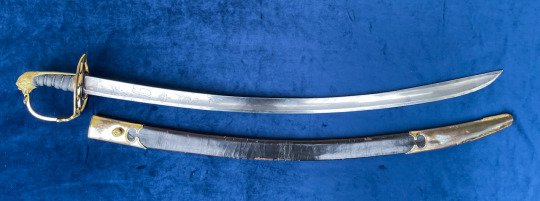

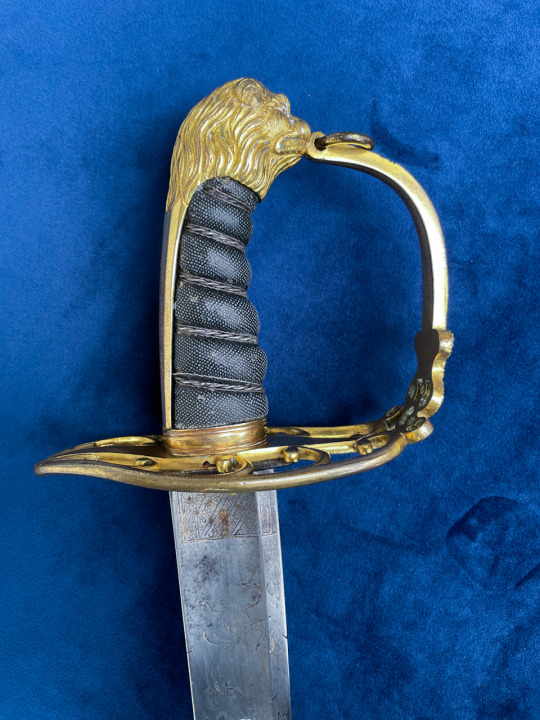
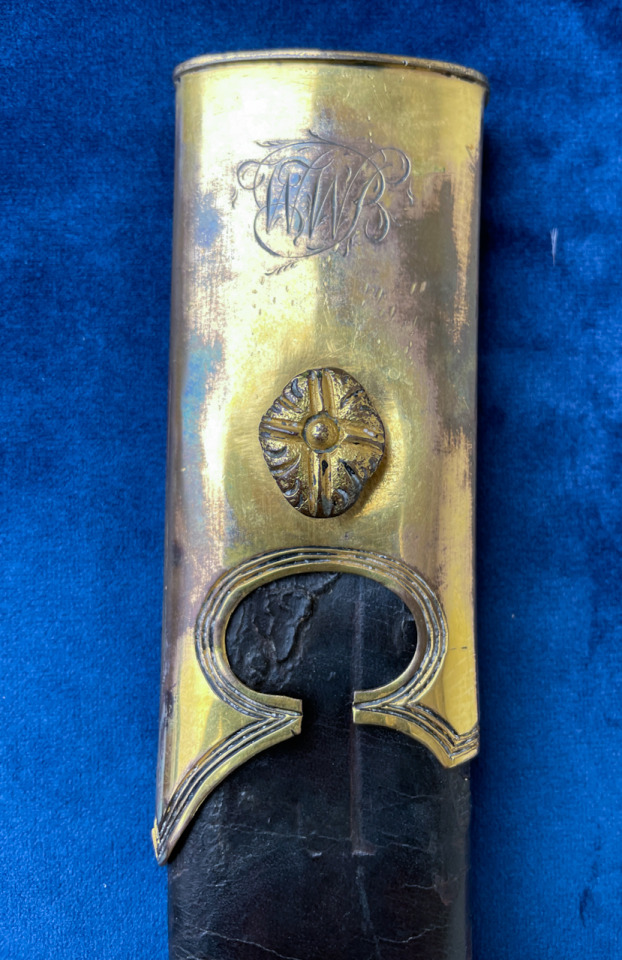


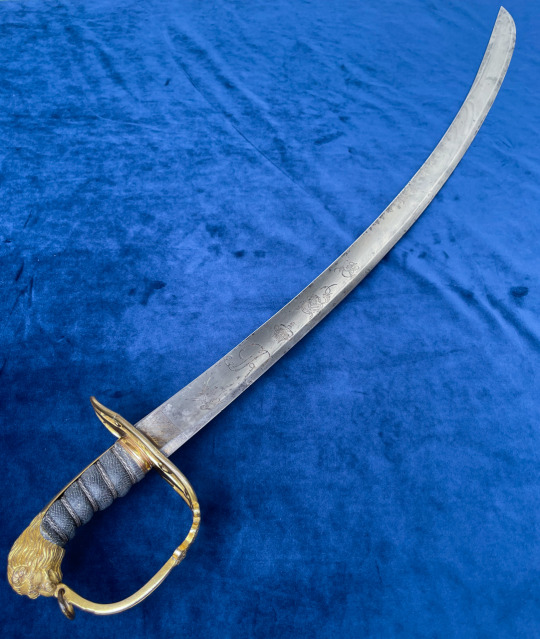

British 1803 Pattern Sword for Officers of Grenadiers and Light Infantry
Accepted as a regulation pattern in early 1803 this sword pattern was a tacit recognition that many officers of the so-called ‘Flank companies’ the regiments’ Light Infantry and Grenadier companies were already choosing to equip themselves with sabres, and rather than try to work against the trend the simply made it official.
This sword was assembled by Prosser, one of the premier sword cutlers of the time using a Solingen made blade that had been imported by J J Runkel. Runkel was a prolific importer of swords and his blades feature prominently on British swords of the time.
This sword has a couple of distinct features, the initials W.W.B are inscribed on the top mount of the scabbard and the guard. These could have been for the original owner, and the 10th Regiment of Foot, the North Lincolnshire show a William Walden Borme in their roster:
October 1794 joined as ensign (second Lieutenant).
August 1795 promoted to Lieutenant by purchase.
August 1804 promoted to Captain.
June 1814 promoted to Major.
If this sword belonged to Major William W. Borme, is impossible to know with absolute certainty, but there is a reasonable chance as the combination of initials is fairly unique.
The other unusual feature is the lack of belt suspension loops, with only a single frog stud on the scabbard throat, it is clear that this sword was intended to be worn from a baldric.
The 1803 pattern related to the hilt and a lot of variation in blade specifications and link many other observed Runkel blades this one is at the beefier end of that spectrum, with a main fuller that runs to the tip. Sadly is has lost all of its’ blue and gilt decoration.
Its’ stats are:
Overall Length: 930 mm
Blade Length: 807 mm
Grip Length: 115 mm
Inside Grip Length: 93 mm
Weight: 780 grams
Point of Balance: 145 mm
Curve: 51 mm
#sword#Sabre#1803 Pattern Officers Sabre#Grenadier Company#Light Infantry#Light Company#British Army#Antiques#Prosser#Napoleonic Wars#Georgian Era
196 notes
·
View notes
Text
Yorktown, 1781

Yorktown, 1781
Read here originally written as part of this much longer work.
Now or never
September 20th, 1781.
The British had trapped themselves, at Yorktown. General Cornwallis had barricaded himself in a Virginian swamp, the Marquis de Lafayette had explained. What’s more the French fleet was more than happy to aid in the destruction of their mutual enemy, Great Britain. Still more, a double agent, a black man by the name of James Armistead Lafayette was feeding English intelligence false information. It was now or never, now that Cornwallis had sent for reinforcements and a fleet from New York.
“We must take Cornwallis, lest we lose all morale and the people,” Washington said.
Tallmadge merely nodded, silent but never not observant holding his Dragoon helmet close.
“It is now or never,” Lafayette said.
These are the times that try men's souls. The summer soldier and the sunshine patriot will, in this crisis, shrink from the service of their country; but he that stands by it now, deserves the love and thanks of man and woman. Tyranny, like hell, is not easily conquered; yet we have this consolation with us, that the harder the conflict, the more glorious the triumph. - Thomas Paine
The trenches
October 11th, 1781.
Several sleepless nights for Major Benjamin Tallmadge as the patriot and allied militias dig trenches surrounding the English enemy. The English put up a fight, of course they do, amidst the darkness sounds of cannons being fired shake the ground and would burst any unaccustomed to war’s eardrums. The smoke from the English muskets fills the air, making it more than a little difficult to breathe, great plumes of white billowing into the air made worse by the southern heat and swampy ground of Virginia and every once in awhile a great booming noise just overhead and something were it less brutal one could half deceive themselves into thinking it a blazing red comet falling to earth.
By morning the trenches are dug, and remarkably, no American casualties, not yet Tallmadge only prayed for the least amount of life taken, and a steady and swift end to this conflict. There are a few casualties on their allies, the French side, but not enough to be noted in any war as substantive. Morale is still high, they need only push Cornwallis til he breaks.
With the right poison, even a snake can take down a lion.
Firestorm
October 15th, 1781.
Across the York River, the sound of a French military drum echoed a steady “da-da-da-dum.” English warships held that side of the river, for the moment. Encroaching in the dead of night the navy of French Admiral Comte de Grasse, set about their cause, the one they were all to pleased to do on General Washington’s insistence.
Raining down cannon fire which soon spread set the vast majority of the English fleet aflame. Tallmadge didn’t see it, not all of it. Truthfully, it was hard to watch, the agony of others, even the enemy, even redcoat lobsters, practically flamed alive. Cornwallis retreated in a small escape vessel but in but a manner of hours, the English fleet at Yorktown and the men who had stood through no fault of their own for their… King and Country were obliterated.
Tallmadge sucked in his breath nervously as recollections of Sarah Livingston passed briefly before his blue eyes. It was necessary, sure, and he wouldn’t run. But… such ungodly suffering, like flames lapping up from Hell, consuming everything in it’s wake.
The cannons, are like a heart beat that rips through you and tears you up. That tears the unlucky limb by limb. Worse than any bullet.
Some talk of Alexander and some of Hercules
Of Hector and Lysander, and such great names as these.
But of all the world's brave heroes, there's none that can compare.
With a tow, row, row, row, row, row, to the British Grenadiers.
Man or a monster
October 16th, 1781.
It had occurred to Benjamin but once before now that he might be wrong, even after all this time, Sarah’s words rang in his ears, ‘I am not ready to die for yours,’ Sarah had said, she had begged his assistance, and he had not returned it, he had killed her. As Comte de Grasse had demolished the English fleet and the man aboard those ships. It must be wrong, surely, or at least, not anything any Good God would approve of, on either side. His name was already tainted, at least to him, it was a wonder anyone could still see Good in him.
Benjamin, son of the right hand in Hebrew, is the chosen son. Or so one in all their wisdom had explained.
Wrong, would this be counted against him or for him, on the day he finally passes? As is most certain and unavoidable for all mankind.
Laying in his cot in his tent Tallmadge managed a prayer. A meek one, but, a prayer nonetheless. Tallmadge would do his duty, finish his task, mount his horse with his spurs and take up his musket and pistols were it so required. But, when this is over and he, at last, can hang up his spurs and his sword– he promises never to lay a hand on a gun or such a fatalistic tool as a sabre ever again. Such destruction and what cost? Surely it is only right for God to play such drawn-out affairs with life and death.
‘But what if perhaps God doesn’t exist?’
But it is surely not Benjamin’s place to question God’s design, faith and friends had kept him alive, however much he wavered and seemed ill at ease. It had been six years fighting George III’s empire, he would surely not break now. Even if it condemned his soul from thereafter.
Even if it made Benjamin no better than the demon or a Lamia the scriptures warn men about.
Redcoats redder
October 17th, 1781.
So the bombardment of the English began in earnest at last. Benjamin was aching for a fight and so it seemed were his colleagues Alexander Hamilton and John Laurens. Washington promised them soon enough – they must break the English defensive in its entirety first. 2,500 Patriots and 4,000 French allies… up against 8,000 English troops. But, as fate or God would have it, 8,000 unguarded, ill of malaria and dysentery and trying to hold a strategic position on land any sensible person would say was unholdable.
Perhaps it was just Cornwallis’s spite for the Americans, the English always seemed to forget the collective power of her colonies, or perhaps more foolish yet, holding out for reinforcements from New York. What it was, didn’t matter. Not when the clock was ticking and in this rare instance, God seemed to favour the patriot side. They’d take the remaining redoubts by storm it is either that or the noose. Liberty or death.
Benjamin had thought on the concept of dying now so many times, it seemed, he now had a sort of disconnect from the entire concept. That was until now. Until he could no longer deny its likelihood. Guns and strategic advantages aside, they were still outnumbered and they were still facing the worlds greatest Empire, if one could call it that. Tallmadge much preferred the concept of putting down a hungry beast, like a Mantacore of Greek legend, or… Echidna the mother of monsters from the same. Surely that was the most apt description for the thing they were fighting. Even bloodsucker or a leech was far too kind.
So, into the belly of the beast they charge, it is, simply… win or the bayonet end or the noose of the hollow crown.
Rochambeau
October 18th, 1781.
The code word, Alexander Hamilton informed him: Rochambeau. We face them now, staring into the whites of their eyes, so the enemy cannot run. Alexander Hamiton and his Achilles, to his Patroclus to his Achilles, John Laurens would lead infantry. Benjamin would, such as his rank of 2nd continental light dragoon said, was to cut them off as calvary give little room for them to hold ground, or fight back. It would be brutal, Hamilton bluntly said to Tallmadge, but necessary. Tallmadge nodded, despite himself and gave Hamilton a friendly and determined smile, this is what Benjamin’s been fighting for since 1776. He was not about to give these men in red an inch. For Nathan, for how he couldn’t spare Major Andre, or Sarah, to end the conflict Miss Shippen was running from. For Anna Strong’s revenge, for Caleb and the ring, for their America.
Not charging into the frey not yet. Alexander and Laurens move silently in the dead of night removing the bullets from their guns until absolutely necessary. With the British defences pummelled to the ground, they take the redoubts with comparative ease. Until the English answer with their remaining cannons and the fog and fumes of war. Laurens and Hamilton stay their ground. Try as men might atop his horse, the men in red are easy targets. He cuts them down hacking and slashing with all his rage and all his might, like Achilles at Troy. They attempt to fire upon him and the calvary he is missed. One man’s horse is shot from under him and he hears the screams of an injured or dying animal, still, they keep fighting. Cannon fire shoots back in response, a last-ditch attempt by the English to hold their position. By 4 am it is decided in the end the total casualties amounted to 857, for both sides. But, outgunned, outplayed, exhausted and ill the English now as weary as their patriot enemies surrender.
The world turned upside down
October 19th, 1781.
A young redcoat stands atop the defences with a white handkerchief, and a drummer accompanies him. By 10:30 am the English offer sufficient terms of surrender. Humiliated, or ill, Cornwallis neglects to be present. Benjamin cannot help but scoff but he suppresses it if only out of politeness and civility to the now-defeated enemy.
A line is formed and sure enough, Washington receives the sword of the enemy, a symbol of surrender and a remarkably civil surrender at that. Save for poor Banastre Tarleton, not with his reputation for brutality. However, the English refuse to look at the Patriots, to whom the French and English are subordinate.
The Marquis de Lafayette merely sighed softly. “Yankee doodle,” he commanded, as the British drummer and fifer played the folk song, ‘The world turned upside down.’ There is a look of disbelief on the faces of the English, but, Tallmadge cannot help but return it with a grin, smug perhaps, but, this is what he had spent six years fighting for! What is more, he had survived.
#muse: benjamin tallmadge#history doesn’t repeat it rhymes / solos#battle of Yorktown#american revolution#18th century#historical fiction#my writing#on this day in history#ic / permitted excesses#benjamin tallmadge#ben tallmadge#aes / the lovers you take are dangerous#turn: washington's spies#turn amc#amc turn#turn washington's spies#drabbles#solos#drabble#for skill in music named / queue#violence cw#war cw
8 notes
·
View notes
Text

New Don Troiani just dropped!
This one is depicting the storming of Redoubt No. 9 at the close of the Siege of Yorktown, 14 October 1781.
After campaigning through Virginia in 1781, Major General Cornwallis’s Crown forces had established a base at Yorktown, a seemingly ideal spot since it provided easy access to the sea, and thus supplies and reinforcements from the Royal Navy.
What Cornwallis hadn’t counted on was a major joint French and American revolutionary operation that would not only bring a French and Continental force to besiege him by land, but also a French fleet to block off access by the sea.
The siege that followed progressed rapidly. Yorktown’s main defences were protected by a number of redoubts, small fortifications sitting a little out from the primary defensive lines. Two redoubts, numbered 9 and 10, were earmarked to be captured by the besiegers. On the night of 14 October Continental Army light infantry would attack redoubt 10, while their French allies attacked redoubt 9.
The multinational nature of the American Revolution comes to a head here. The 120ish Crown defenders of redoubt 9 included detachments from several English and Scottish regiments as well as Germans from the Hessian Regiment von Bose. There was variation even among the Scots, with highlanders from the 71st Regiment (Fraser’s highlanders), and lowlanders from the 80th Regiment (Royal Edinburgh Volunteers).
The attacking French force primarily consisted of the grenadiers and chasseurs (light infantry) of two regiments, Gatinais and Royal Deux-Points, but the latter regiment actually mostly consisted of Germans from the states of the Holy Roman Empire.
After darkness fell, and following a thunderous bombardment, the attack got underway. The French first had to clear the abatis (basically stakes and sharp undergrowth) lining the ditch in front of the redoubt. Charpentiers wielding axes did this, hacking a path. The assault force then stormed up and into the redoubt, roaring ‘long live the king’ and ‘kill, kill.’ The fighting was some of the most brutal of the Revolutionary War. One German in Royal Deux-Points, Georg Daniel Flohr, leaves a grim account;
‘Anyone can imagine what happened once we were inside the redoubt. People of four nations were thrown together: Frenchmen, English, Scots, and Germans… the soldiers… were so furious that our people were killing one another. The French were striking down everyone in a blue coat. Since the Deux-Ponts wore blue, many of us were stabbed to death… One screamed here, the other there, that for the grace of God we should kill him off completely. The whole redoubt was so full of dead and wounded that one had to walk on top of them.’
Artwork is, of course, by Don Troiani and reproduced with permission. Prints available for purchase on the W Britain website.
#history#military history#18th century#american revolution#american war of independence#revwar#yorktown#siege of yorktown
37 notes
·
View notes
Note
continuing our birb discussion... i wanted to ask, are there any real purple birbs?
(no pressure to answer!)
Mmmmm it's 4am rn bcuz I'm a bit of a fool and was drawing my Dungeons and Dragons Owlin character sooo beware my rambling and nonsense ahah ;;
Anyways! There are so many purple birds out there, it's very lovely. However you said "real" purple birds and I may be overthinking this cuz it's late but it reminded me about how blue isn't a real color on birds because there's nothing in a bird's diet that allows for that sort of blue pigmentation. Yknow how bell peppers can be like...red and yellow? Yeah it's cuz they have some antioxidants called carotenoids that create the red/yellow/orange pigmentation. (Pink flamingos are pink cuz shrimp...what would blue birds eat to make them blue? There's really not a blue fruit out there. Don't say blueberries.) And the answer researchers found out for blue on birds feathers is cuz of light wavelength.
Protein structure specifically keratin in their feathers (stuff ur nails and hair is made up of!) kinda refract the blue wavelengths and since all color we see are the colors that aren't absorbed...well. blue!
But for purple--and this is a guess cuz im pulling this out from what i remember of my nutrition class--purple may be their true color. Cuz carotenoids can also mix and match structurally and allow for some green and off kilter blue pigmentation to occur. And yknow. Blue and red = purple.
So. Maybe purple birds. Will do research later. But there are many. Many lovely ones that we can actually see. For example, and my favorite cuz I participated in a volunteer opportunity for these guys:
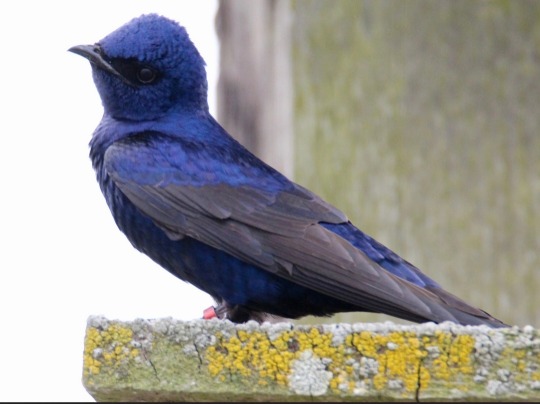
Purple Martins! What lovely guys, they flock in the hundreds. Seeing these guys pass by overhead was so cool. Ok maybe they're a bit more indigo but they're adorable regardless.
Though if you want a very very vibrant purple.
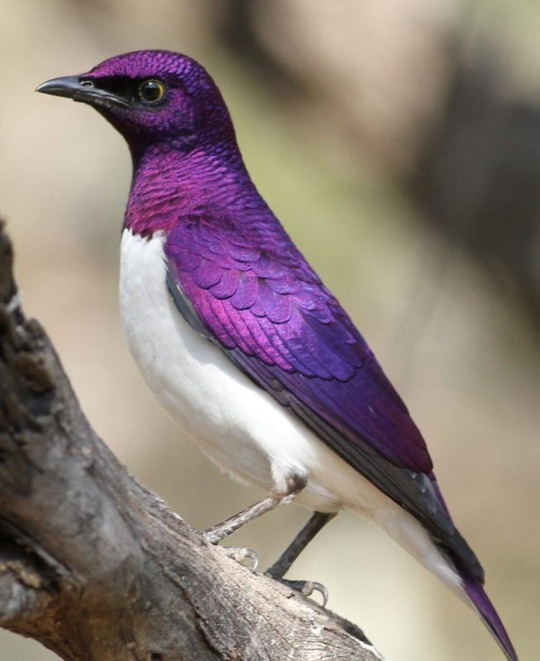
Violet-backed Starlings. What a banger bird. This bird just knew how to win in the fashion show. This tone of purple with white? Urgh. Slaps. Iridescent too.. lovely.
You're a corvid enjoyer. I think you'll get a kick outta this guy.

Purplish Jay! No I'm not kidding about the name. It's kinda funny cuz it's like hmmm you're not really purple but still purple enough sjjshaha silly!! I love human naming conventions
I know there's a bunch of hummingbirds that have purple feathers I wonder why. Oh flowers. Flowers maybe?? Nectar?? *shrugging noises*
Anyways, personal favorite of the hummingbirds

Lucifer hummingbirds! Have no clue why they named such a tiny lil guy with such a name but humans are silly. Just like birds. I wish there was carcinisation but for birds. Ornithonisation?
Ok I'm not making sense anymore here's the names of other purple birds off the top of my head:
violet-crowned hummingbird.
Purple breasted cotinga. (Cotingas are such goofy birds).
Purple honeycreeper (what a name. Imagine creeping on honey i dont think they even eat honey, just flower nectar.)
Purple Grenadier (finches beloved)
And I forgot the name but it's a Turaco
Anyways good night!! I love chattering about birds
#hmmm birds beloved#birds#this bird speams#coffee my beloved enjoyers!! enjoy bird#oh my...ur kinda a purplish jay yourself. oh maybe a Rook. they have such curious mating dances. but the white face aesthetic is banger#oh but u give me red vibes. i cannto explain why. so maybe a red winged black bird. ur kinda a black bird energy too.#what am i even syng right now??#this bird speaks#this bird responds
6 notes
·
View notes
Text


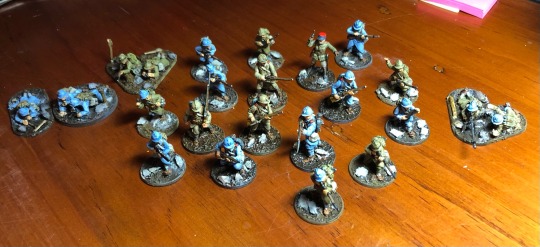
My winnings from the recent local Bolt Action event. This is the start if a 1940 reserve french platoon. The list is predominantly made up of inexperienced sections, anti-tanks and rifle-grenades. This is my ‘grenadiers’ list… i do not expect them to live through any engagement, but think of the stories! Also i wanted to paint ‘horizon blue’ and french reserves made the most sense…
2 notes
·
View notes
Text
Keith Windham’s Uniform: A Long and Highly Speculative Deep Dive into the Royal Scots’ Uniform in 1745
This is something I’ve wanted to research for a while—uniformology tends to be my favorite aspect of military life, so naturally, provided with a redcoat officer protagonist who quickly stole my heart as a character, I wanted to be able to do his uniform justice in my depictions of him. Let me first start by saying that there is no shortage of excellent art in this fandom, and furthermore, most of the uniforms I have seen depicted in said art actually seem quite well-researched and accurate, especially given the limited information available. I by no means pretend to be an expert on this matter—I am much more familiar with late 18th century AWI era uniforms, and even then I am no scholar—but this time period in uniform history is surprisingly elusive, and I felt inclined to find out more by doing a bit of a (admittedly self-indulgent) deep dive. This will be a long post, intended to be something of a reference, largely for myself, detailing the specific appearance of our Major Windham’s uniform as best I can.
It must first be established, however, that information on this specific period of uniform is scant. My first “launching point” was this excellent post by Bantarleton discussing British uniforms during the Jacobite Rising (which I highly recommend checking out for more qualified Speculation), which also served to corroborate what I was already beginning to see in my research: between the years of 1742 and 1751, we lack any solid evidence as to what British uniforms may have looked like. The hypothetical image I am assembling here is based, therefore, largely on educated speculation, as are most of the modern depictions of uniforms during this time period. Take all of this with a grain of salt, as you would any other historical post by a user on Tumblr, and bear in mind once again that I am not a scholar. But with that being said, we can begin in the closest place that we do have visual evidence: in 1742.
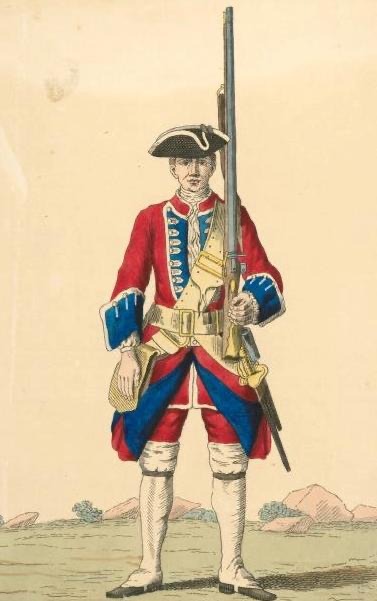
It was during this year that the Cloathing Book was commissioned by the Duke of Cumberland for King George II, which depicts the regular soldier’s regimental uniform across the military. Here we take a look at the 1st Royal Regiment (Royal Scots, though they would not be officially called that until the 19th century) uniform, which our Keith presumably would have worn some three years prior to canon, though assumedly not as a regular, which this soldier is.
Our second concrete visual of the same regimental uniform comes from 1751, portrayed by David Morier, who was commissioned probably by the Duke of Cumberland to paint a grenadier from each regiment. Why grenadiers, we can’t know—maybe for their fancy caps—but the uniform is essentially the same as would be the regular’s, with the exception of the cap (interestingly, I discovered the flanking company “wings” would be introduced only in 1752). The officers and the battalion men would all have been wearing cocked hats similar to the one portrayed in the previous photo.
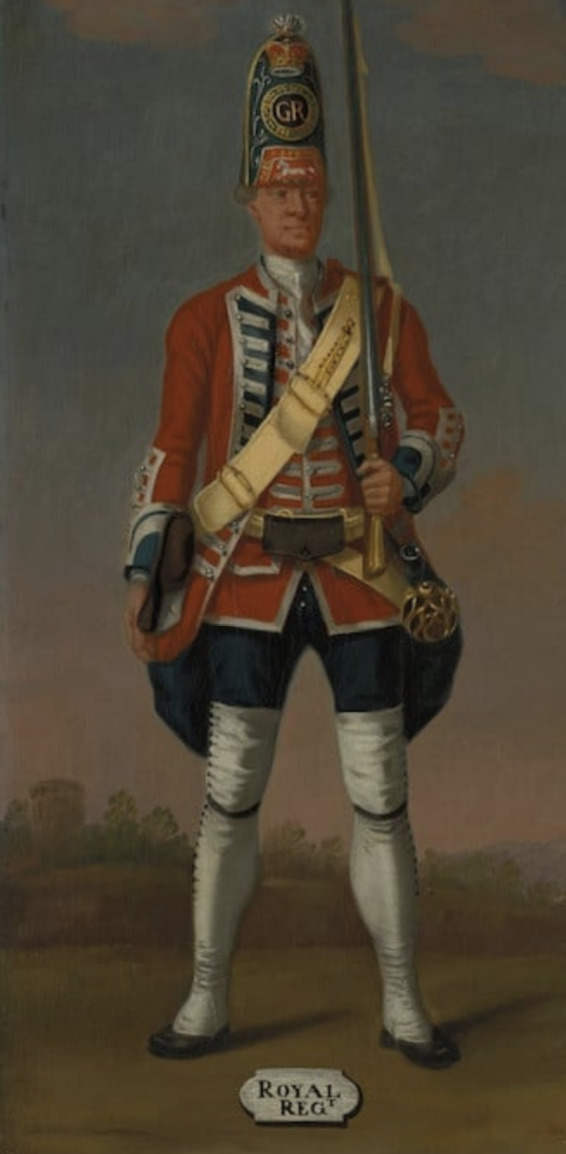
Comparing the two, we see some changes in the silhouette and the smallclothes (in 1751 the breeches change to be blue instead of red), but nothing too drastic. I for one hadn’t realized that the Royal Scots would have been wearing red smallclothes during the mid century, as opposed to the white or buff. The one thing which does confuse me is the lack of lacing on the cuffs in 1742. Take this example, from the same collection, of a soldier from the 34th Regiment—notice the split cuffs and their elaborate lacing.
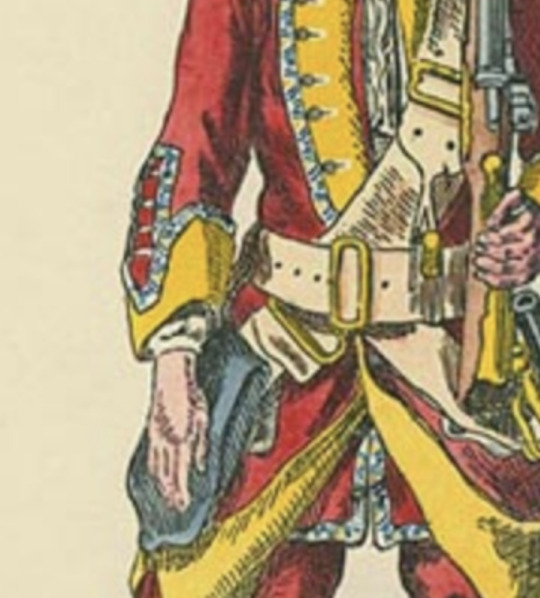
The artist seems to have been very deliberate in his depiction of the 1st’s uniform to include full cuffs without that extra lacing. Unfortunately I can’t seem to corroborate whether this was intentional or not, but my best guess is that it might have been a deliberate sign of the 1st Royals’ seniority: most regiments (like the 34th seen here) wore their own specific patterned lace, but the Royal Scots (at least during the mid 18th century) specifically wore plain white lace as a nod to the fact that they were the first and oldest regiment established in the British Army. It seems not impossible that this simpler cuff design might have been intended to convey the same sentiment. However, I can‘t say for sure whether this was the cuff in use during 1745, unfortunately. I would lean more toward the 1742 uniform for Keith’s just because it’s closer time-wise, but given that new uniforms were issued every year, it’s impossible to truly know how similar it would have been.
All that being said, it is important to acknowledge that we have been discussing regular soldiers up until this point: our Major Windham’s uniform would have borne some distinctions. This is a modern (so once again, speculative) illustration of an officer of the 7th Dragoon Guards in 1745, who, while not being an infantry soldier, would still have had a comparable uniform at the officers’ level, and provides a pretty good example of what some of these officers' distinctions might have looked like.

With regard to lace, officers’ uniforms of the 1st Royals were faced with gold lace as opposed to white, including on the hat. As mentioned before, as an officer, Keith would have been wearing a cocked hat with a black cockade on the left side, unlike the grenadier in the previous painting. While on duty, it seems likely that he would have worn a gilt gorget, though in a broader kind of half-moon shape than would be seen at the end of the century, and a sash, over his shoulder and the rest of his uniform rather than around his waist. He also would not have worn the crossbelts we see the regular soldiers wearing, and instead probably only a waist belt to hold his sword. Another important distinction would have been the gold aiguillette, a decorative knot to denote rank, rather than an epaulette like we see in the later century, on his right soldier, like the one on the dragoon officer’s shoulder here. An interesting but subtle detail would have been the fact that officers’ coats generally did not have the turned-back skirts associated with regular soldiers; the idea was that those soldiers would be moving around a lot more than the officers and therefore would need the extra room.
Another thing not specific to being an officer, but simply which differs from the paintings here, is that while on duty all soldiers (officers included) would have been wearing black gaiters, and not white. While, in my opinion, they do look fantastic (especially the full length mid century ones, unlike the late century half-gaiters…), white gaiters were reserved for parade because of how easily they could get dirty. While I’m here I suppose it’s worth listing off a couple general period details I often tend to forget about the mid-18th century, as someone who mentally lives in the 1770s: for one thing, military cocked hats were almost always worn slightly off to the side with the “point” angled over the left eye (you can kind of see it in the 1742 depiction). This was so that men could shoulder their firelocks without knocking their hats right off their head, and it became so much of a fashion that not only were officers (who were not bearing muskets) doing it, too, but also some civilians (and this lasted for a long time, pretty much until the army stopped wearing cocked hats). Also, it didn’t occur to me until recently that cravats were much more in fashion than stocks were during this period, and would have been tucked into a waistcoat that might have been even nearly half unbuttoned from the top, as was the fashion at the time.
But now I’m just rambling. I had fun learning about this and if someone else learns from it too, that’s just a bonus to me. Again, I'm not an expert; this is in no way meant to “correct” any of the depictions of Keith I’ve seen, or come off at all as being in bad faith. Almost everything I’ve said in this post is stuff I wasn't sure of myself until looking into, because this kind of thing is hard to know! As I said, most of the Keiths I see actually seem very well-researched and faithfully depicted. I just happen to love uniforms, and this man happens to have one (and a very good one at that). I would lean most heavily toward the 1742 version for Keith’s canon uniform if only because it’s closer in time to anything else we have, but who can really say what it looked like in real life? Some part of me is saddened to know we’ll likely never know, but thus is history. Hopefully knowing all this I’ll be able to do it some justice.
#wooooof.... long post#at some point hopefully i'll just like. draw it. but not today it's 2am#really interesting to look into though#one thing about me is I Love Uniforms#anyway#18thc#uniforms#flight of the heron#the flight of the heron#foth#keith windham#reference#jacobite rising#long post#redcoatposting#this is your captain speaking#haul up your queuegarnets#the captain's lectures
22 notes
·
View notes